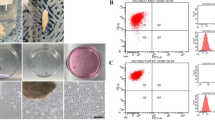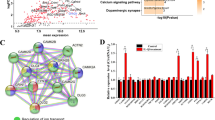Abstract
Ion channels included in the family of Connexins (Cx) have been reported to influence the secondary expansion of traumatic spinal cord injury (SCI) and neuropathic pain following SCI. However, Cxs also contribute to spinal cord neurogenesis during the remyelinating process and functional recovery after SCI. Certain Cxs have been recently related to the control of cell proliferation and the differentiation of neuronal progenitors. Adult spinal-cord-derived ependymal stem progenitor cells (epSPC) show high expression levels of Cx50 in non-pathological conditions and lower expression when they actively proliferate after injury (epSPCi). We explore the role of Cx50 in the ependymal population in the modulation of Sox2, a crucial factor of neural progenitor self-renewal and a promising target for promoting neuronal-cell-fate induction for neuronal tissue repair. Short-interfering-RNA ablation or over-expression of Cx50 regulates the expression of Sox2 in both epSPC and epSPCi. Interestingly, Cx50 and Sox2 co-localize at the nucleus indicating a potential role for this ion channel beyond cell-to-cell communication in the spinal cord. In vivo and in vitro experiments with Clotrimazole, a specific pharmacological modulator of Cx50, show the convergent higher expression of Cx50 and Sox2 in the isolated epSPC/epSPCi and in spinal cord tissue. Therefore, the pharmacological modulation of Cx50 might constitute an interesting mechanism for Sox2 induction to modulate the endogenous regenerative potential of neuronal tissue with a potential application in regenerative therapies.





Similar content being viewed by others
References
Barnabe-Heider F, Goritz C, Sabelstrom H, Takebayashi H, Pfrieger FW, Meletis K, Frisen J (2010) Origin of new glial cells in intact and injured adult spinal cord. Cell Stem Cell 7:470–482
Bautista W, Nagy JI (2014) Connexin36 in gap junctions forming electrical synapses between motoneurons in sexually dimorphic motor nuclei in spinal cord of rat and mouse. Eur J Neurosci 39:771–787
Bautista W, Nagy JI, Dai Y, McCrea DA (2012) Requirement of neuronal connexin36 in pathways mediating presynaptic inhibition of primary afferents in functionally mature mouse spinal cord. J Physiol (Lond) 590:3821–3839
Bautista W, McCrea DA, Nagy JI (2014a) Connexin36 identified at morphologically mixed chemical/electrical synapses on trigeminal motoneurons and at primary afferent terminals on spinal cord neurons in adult mouse and rat. Neuroscience 263:159–180
Bautista W, Rash JE, Vanderpool KG, Yasumura T, Nagy JI (2014b) Re-evaluation of connexins associated with motoneurons in rodent spinal cord, sexually dimorphic motor nuclei and trigeminal motor nucleus. Eur J Neurosci 39:757–770
Bodendiek SB, Rubinos C, Trelles MP, Coleman N, Jenkins DP, Wulff H, Srinivas M (2012) Triarylmethanes, a new class of cx50 inhibitors. Front Pharmacol 3:106
Boyer LA, Lee TI, Cole MF, Johnstone SE, Levine SS, Zucker JP, Guenther MG, Kumar RM, Murray HL, Jenner RG, Gifford DK, Melton DA, Jaenisch R, Young RA (2005) Core transcriptional regulatory circuitry in human embryonic stem cells. Cell 122:947–956
Chen MJ, Kress B, Han X, Moll K, Peng W, Ji RR, Nedergaard M (2012) Astrocytic CX43 hemichannels and gap junctions play a crucial role in development of chronic neuropathic pain following spinal cord injury. Glia 60:1660–1670
Chew JL, Loh YH, Zhang W, Chen X, Tam WL, Yeap LS, Li P, Ang YS, Lim B, Robson P, Ng HH (2005) Reciprocal transcriptional regulation of Pou5f1 and Sox2 via the Oct4/Sox2 complex in embryonic stem cells. Mol Cell Biol 25:6031–6046
Cronin M, Anderson PN, Cook JE, Green CR, Becker DL (2008) Blocking connexin43 expression reduces inflammation and improves functional recovery after spinal cord injury. Mol Cell Neurosci 39:152–160
Dang X, Doble BW, Kardami E (2003) The carboxy-tail of connexin-43 localizes to the nucleus and inhibits cell growth. Mol Cell Biochem 242:35–38
Duval N, Gomes D, Calaora V, Calabrese A, Meda P, Bruzzone R (2002) Cell coupling and Cx43 expression in embryonic mouse neural progenitor cells. J Cell Sci 115:3241–3251
Gaete M, Munoz R, Sanchez N, Tampe R, Moreno M, Contreras EG, Lee-Liu D, Larrain J (2012) Spinal cord regeneration in Xenopus tadpoles proceeds through activation of Sox2-positive cells. Neural Dev 7:13
Gomez-Villafuertes R, Rodriguez-Jimenez FJ, Alastrue-Agudo A, Stojkovic M, Miras-Portugal MT, Moreno-Manzano V (2015) Purinergic receptors in spinal cord-derived ependymal stem/progenitor cells and its potential role in cell-based therapy for spinal cord injury. Cell Transplant 24:1493–1509
Goncharenko K, Eftekharpour E, Velumian AA, Carlen PL, Fehlings MG (2014) Changes in gap junction expression and function following ischemic injury of spinal cord white matter. J Neurophysiol 112:2067–2075
Han Y, Yu HX, Sun ML, Wang Y, Xi W, Yu YQ (2014) Astrocyte-restricted disruption of connexin-43 impairs neuronal plasticity in mouse barrel cortex. Eur J Neurosci 39:35–45
Hartfield EM, Rinaldi F, Glover CP, Wong LF, Caldwell MA, Uney JB (2011) Connexin 36 expression regulates neuronal differentiation from neural progenitor cells. PLoS One 6:e14746
Huettner JE, Lu A, Qu Y, Wu Y, Kim M, McDonald JW (2006) Gap junctions and connexon hemichannels in human embryonic stem cells. Stem Cells 24:1654–1667
Jiang JX, Gu S (2005) Gap junction- and hemichannel-independent actions of connexins. Biochim Biophys Acta 1711:208–214
Kanczuga-Koda L, Sulkowski S, Koda M, Sulkowska M (2005) Alterations in connexin26 expression during colorectal carcinogenesis. Oncology 68:217–222
Ke Q, Li L, Cai B, Liu C, Yang Y, Gao Y, Huang W, Yuan X, Wang T, Zhang Q, Harris AL, Tao L, Xiang AP (2013) Connexin 43 is involved in the generation of human-induced pluripotent stem cells. Hum Mol Genet 22:2221–2233
Kim JB, Zaehres H, Wu G, Gentile L, Ko K, Sebastiano V, Arauzo-Bravo MJ, Ruau D, Han DW, Zenke M, Scholer HR (2008) Pluripotent stem cells induced from adult neural stem cells by reprogramming with two factors. Nature 454:646–650
Krutovskikh VA, Troyanovsky SM, Piccoli C, Tsuda H, Asamoto M, Yamasaki H (2000) Differential effect of subcellular localization of communication impairing gap junction protein connexin43 on tumor cell growth in vivo. Oncogene 19:505–513
Kunzelmann P, Schroder W, Traub O, Steinhauser C, Dermietzel R, Willecke K (1999) Late onset and increasing expression of the gap junction protein connexin30 in adult murine brain and long-term cultured astrocytes. Glia 25:111–119
Lee IH, Lindqvist E, Kiehn O, Widenfalk J, Olson L (2005) Glial and neuronal connexin expression patterns in the rat spinal cord during development and following injury. J Comp Neurol 489:1–10
Lee HJ, Wu J, Chung J, Wrathall JR (2013) SOX2 expression is upregulated in adult spinal cord after contusion injury in both oligodendrocyte lineage and ependymal cells. J Neurosci Res 91:196–210
Liebmann M, Stahr A, Guenther M, Witte OW, Frahm C (2013) Astrocytic Cx43 and Cx30 differentially modulate adult neurogenesis in mice. Neurosci Lett 545:40–45
Livak KJ, Schmittgen TD (2001) Analysis of relative gene expression data using real-time quantitative PCR and the 2(−Delta Delta C(T)) method. Methods 25:402–408
Mao AJ, Bechberger J, Lidington D, Galipeau J, Laird DW, Naus CC (2000) Neuronal differentiation and growth control of neuro-2a cells after retroviral gene delivery of connexin43. J Biol Chem 275:34407–34414
Meletis K, Barnabe-Heider F, Carlen M, Evergren E, Tomilin N, Shupliakov O, Frisen J (2008) Spinal cord injury reveals multilineage differentiation of ependymal cells. PLoS Biol 6:e182
Mennecier G, Derangeon M, Coronas V, Herve JC, Mesnil M (2008) Aberrant expression and localization of connexin43 and connexin30 in a rat glioma cell line. Mol Carcinog 47:391–401
Moreno-Manzano V, Rodriguez-Jimenez FJ, Garcia-Rosello M, Lainez S, Erceg S, Calvo MT, Ronaghi M, Lloret M, Planells-Cases R, Sanchez-Puelles JM, Stojkovic M (2009) Activated spinal cord ependymal stem cells rescue neurological function. Stem Cells 27:733–743
Mothe AJ, Tator CH (2005) Proliferation, migration, and differentiation of endogenous ependymal region stem/progenitor cells following minimal spinal cord injury in the adult rat. Neuroscience 131:177–187
Mothe AJ, Zahir T, Santaguida C, Cook D, Tator CH (2011) Neural stem/progenitor cells from the adult human spinal cord are multipotent and self-renewing and differentiate after transplantation. PLoS One 6:e27079
Munoz R, Edwards-Faret G, Moreno M, Zuniga N, Cline H, Larrain J (2015) Regeneration of Xenopus laevis spinal cord requires Sox2/3 expressing cells. Dev Biol 15:229–243
Namiki J, Tator CH (1999) Cell proliferation and nestin expression in the ependyma of the adult rat spinal cord after injury. J Neuropathol Exp Neurol 58:489–498
Panayiotou E, Malas S (2013) Adult spinal cord ependymal layer: a promising pool of quiescent stem cells to treat spinal cord injury. Front Physiol 4:340
Park S, Lee EJ, Chun HJ, Keum B, Seo YS, Kim YS, Jeen YT, Lee HS, Um SH, Kim CD, Ryu HS, In KH, Uhm CS, Lee SJ (2011) Electron microscopic study of intercellular space: correlation analysis of bronchial asthma and gastroesophageal reflux disease. J Gastroenterol Hepatol 26:104–107
Patel D, Zhang X, Veenstra RD (2014) Connexin hemichannel and pannexin channel electrophysiology: how do they differ? FEBS Lett 588:1372–1378
Petit A, Sanders AD, Kennedy TE, Tetzlaff W, Glattfelder KJ, Dalley RA, Puchalski RB, Jones AR, Roskams AJ (2011) Adult spinal cord radial glia display a unique progenitor phenotype. PLoS One 6:e24538
Rodriguez-Jimnez FJ, Alastrue-Agudo A, Erceg S, Stojkovic M, Moreno-Manzano V (2012) FM19G11 favors spinal cord injury regeneration and stem cell self-renewal by mitochondrial uncoupling and glucose metabolism induction. Stem Cells 30:2221–2233
Rodriguez-Jimenez FJ, Alastrue-Agudo A, Stojkovic M, Erceg S, Moreno-Manzano V (2015) Connexin 50 expression in ependymal stem progenitor cells after spinal cord injury activation. Int J Mol Sci 16:26608–26618
Roscoe WA, Messersmith E, Meyer-Franke A, Wipke B, Karlik SJ (2007) Connexin 43 gap junction proteins are up-regulated in remyelinating spinal cord. J Neurosci Res 85:945–953
Rozental R, Morales M, Mehler MF, Urban M, Kremer M, Dermietzel R, Kessler JA, Spray DC (1998) Changes in the properties of gap junctions during neuronal differentiation of hippocampal progenitor cells. J Neurosci 18:1753–1762
Russo RE, Reali C, Radmilovich M, Fernandez A, Trujillo-Cenoz O (2008) Connexin 43 delimits functional domains of neurogenic precursors in the spinal cord. J Neurosci 28:3298–3309
Su Z, Niu W, Liu ML, Zou Y, Zhang CL (2014) In vivo conversion of astrocytes to neurons in the injured adult spinal cord. Nat Commun 5:3338
Todorova MG, Soria B, Quesada I (2008) Gap junctional intercellular communication is required to maintain embryonic stem cells in a non-differentiated and proliferative state. J Cell Physiol 214:354–362
Usul H, Cakir E, Arslan E, Peksoylu B, Alver A, Sayin OC, Topbas M, Baykal S (2006) Effects of clotrimazole on experimental spinal cord injury. Arch Med Res 37:571–575
Usul H, Arslan E, Cansever T, Cobanoglu U, Baykal S (2008) Effects of clotrimazole on experimental spinal cord ischemia/reperfusion injury in rats. Spine 33:2863–2867
Weiss S, Dunne C, Hewson J, Wohl C, Wheatley M, Peterson AC, Reynolds BA (1996) Multipotent CNS stem cells are present in the adult mammalian spinal cord and ventricular neuroaxis. J Neurosci 16:7599–7609
White TW, Goodenough DA, Paul DL (1998) Targeted ablation of connexin50 in mice results in microphthalmia and zonular pulverulent cataracts. J Cell Biol 143:815–825
Worsdorfer P, Maxeiner S, Markopoulos C, Kirfel G, Wulf V, Auth T, Urschel S, Maltzahn J von, Willecke K (2008) Connexin expression and functional analysis of gap junctional communication in mouse embryonic stem cells. Stem Cells 26:431–439
Xu Q, Cheong YK, He SQ, Tiwari V, Liu J, Wang Y, Raja SN, Li J, Guan Y, Li W (2014) Suppression of spinal connexin 43 expression attenuates mechanical hypersensitivity in rats after an L5 spinal nerve injury. Neurosci Lett 566:194–199
Acknowledgments
We thank María Teresa Calvo-Fernandez, Fabrice Durupt, Francesca De Giorgio, Maravillas Mellado, Erik Lopez-Mocholi and Alicia García-Jareño for their excellent technical support.
Author information
Authors and Affiliations
Corresponding author
Ethics declarations
Conflict of Interest
The authors declare that they have no conflicts of interest.
Ethical approval
All applicable international and/or national guidelines for the care and use of animlas were followed. All procedures performed in studies involving animlas were in accordance with the ethical standards of the institution or practice at which the studies were conducted.
Additional information
This study was funded by grants CONSOLIDER-INGENIO 2010 CSD2008-00005 from the Ministerio de Economía y Competitividad and PI10/01683 and PI13/00319 from the Instituto de Salud Carlos III.
Rights and permissions
About this article
Cite this article
Rodriguez-Jimenez, F.J., Alastrue, A., Stojkovic, M. et al. Connexin 50 modulates Sox2 expression in spinal-cord-derived ependymal stem/progenitor cells. Cell Tissue Res 365, 295–307 (2016). https://doi.org/10.1007/s00441-016-2421-y
Received:
Accepted:
Published:
Issue Date:
DOI: https://doi.org/10.1007/s00441-016-2421-y




